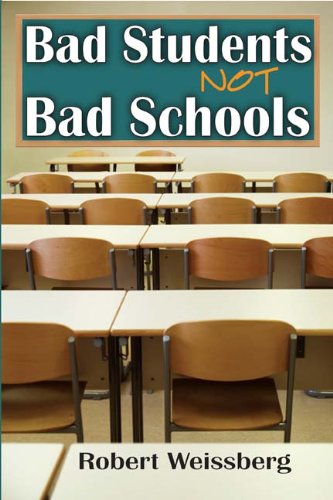 If a prize were awarded for the worst policy idea, one that would waste billions in some futile quest for the impossible, the indisputable winner would be uplifting the academic bottom by fixing their “bad schools.” It is a seductive idea that never seems to die despite repeated failures; it even seduces free-market conservatives infatuated with school choice remedies. What can possibly explain such stupidity?
If a prize were awarded for the worst policy idea, one that would waste billions in some futile quest for the impossible, the indisputable winner would be uplifting the academic bottom by fixing their “bad schools.” It is a seductive idea that never seems to die despite repeated failures; it even seduces free-market conservatives infatuated with school choice remedies. What can possibly explain such stupidity?
Let’s start with the underlying “logic” of this doomed quest—the belief that low-IQ, academically unmotivated youngsters prone to classroom disorder attending schools disinclined to impose discipline can achieve reading and mathematical proficiency by tinkering with school environments. Moreover, that these troubled youngsters already attend well-financed schools with perfectly adequate facilities, small classes, state-certified teachers, ample pedagogical specialists and everything else that physically defines a “good school” is hardly acknowledged. Nor is there any past evidence that this fix-the-environment approach, everything from unscrewing chairs from the floor to cutting-edge technology, has ever moved the academic proficiency needle.
But hope springs eternal and the fantasy’s latest installment was President Obama’s $7 billion dollar failed School Improvement Grants Program whose aim, according to Arne Duncan Obama’s Secretary of Education from 2009 to 2016, was to “turn around” 1000 schools per year over five years (according to the DOE rhetoric, this initiative was to “…implement innovative, effective, ambitious, comprehensive, and locally driven strategies”). Alas, whether calibrated by test scores, graduation rates or college enrollment, nothing helped. And keep in mind that the multi-billion dollar nostrum has been around since the George W. Bush era though the Obama administration significantly increased funding.
How was this money spent? Conceivably, the extra money might have been spent on promoting stronger discipline or shipping trouble-makers to special schools, or, for the more therapeutically inclined, hiring more social workers to treat angry, violent students. What about cutting class size yet further to give teachers a fighting chance to deal with miscreants? Or just add yet more school police?
The answer is “none of the above” though spending details remain a mystery other than the states could distributing it to the poorest performing schools with individual schools, which received up to $2 million per years for three years. And what did Obama’s plan specifically ask for in exchange for this money? Each schools had four options: recruit a new principal, fire and replace half the teachers, convert the school into a charter school (publically funded but privately run), close the school entirely or undergo what the Department of Education (DOE) called a “transformation”—adopt fresh instructional strategies, design new teacher evaluations and have a longer school day. Tellingly, of all four options, a mere 3% elected to become charter schools, one percent closed their school entirely and half selected “transformation,” the one option requiring the least change.
Critically, the DOE did not trace how the money was spent other than what option of the four the under-performing school selected. Nor was there any consideration of whether these schools had students capable of improving academically. The millions arrived, the principal or half the teachers were fired, the teacher evaluation form modified, so end of story. That the new principal could have been a certified fool or the newly hired teachers semi-literates are never examined. By Washington’s definition, any of these four broadly defined decisions constitute “fixing a broken school.”
How is this multi-billion dollar, quite predictable disaster to be explained? Perhaps the kindest explanation is that it just reflects the usual technical ineptitude of professional educators. The telltale signs of such incompetence are everywhere though the report detailing the failure runs for over 400 pages and overflows with intimidating technical jargon. Why, for example, would just terminating the principal or reducing the teaching staff, per se, be causally related to improved student test scores absent specifying the intervening links? Indeed, it would need a miracle for any of these four highly general changes to have a non-random impact on learning. Going one step further, these four potentially causal factors—the independent variables in research parlance—seem to be chosen at random. There is no evidence that that these specified factors are, indeed, factors known to improve test scores. Nor are these hypothesized casual factors defined with sufficient precision so that variations in them can be separated—all curriculum modification, regardless of potentially vital details, are treated as if they were identical though, obviously variations must number in the hundreds. I suspect that these four factors were pulled out of thin air with zero attention to details like the proficiency of newly hired teachers vis-à-vis those they replaced. Hard to imagine the entire billion dollar enterprise surviving even cursory inspection at a decent graduate level course on research design (I’ve taught such courses and in my opinion this plan deserves an “F”).
Equally plausible is that these billions are just a dressed up pay-off to inner-city blacks (and Hispanics), especially in cities where blacks dominate politically with zero consequences for failure. After all, since past multi-billion dollar ameliorative efforts have failed, why would these educators now be held accountable to a higher standard? And the excuses already exist—poverty, racism, a too “white” curriculum, past racial segregation and on and on. Actually, failure may be rational since non-random positive results might invite (reasonable) suspicions of cheating and thus invite unwelcome scrutiny whereas failure goes unnoticed. (This is not Obama’s first hugely expensive fix-the-schools boondoggle. In 2011 Obama proposed spending some $25 billion for 35,000 schools needing new computers, science labs and similar bric-a-brac.)
It would be a snap to game the system. A principal at School A could be fired, and hired at School B while the one from School B is hired at School A, both with hefty salary increases. Just picture the feeding frenzy when newly enriched schools advertise for consultants to help them to tweak textbooks to make them more relevant to the lives of struggling inner-city kids?
Finally, there is a darker, more deceitful explanation for this stupidity, an explanation that also explains why so many conservatives buy into this fix-the-school mentality. To be blunt, the stress on “evil” inanimate objects crowds out any attempt to look at the kids themselves—their limited and non-reversible cognitive ability, their rejection of academics, their inability to control disruptive behavior and, for good measure, the total failure of black educators in black-dominated cities where schools are well-funded. In other words, defining education in terms of, say, the lack of laptops or the absence of school choice, sanitizes discussions of our education tribulations. Now, happily, everyone regardless of ideology can display “concern” and not fear being labeled a racist since biological differences never enter the discussion.
These fix-the-schools mentality will continue even under the Trump administration. Yet again, nobody will dare admit that stupid students are the source of the problem. I have personally have tried to re-focus the discussion on the students themselves, not their environment, with scant impact. The awkward reality of why desperately poor Vietnamese immigrants excel academically while native-born blacks fail is an unspeakable taboo. Government happily flushes billions down the toilet to sustain lies.
Written by Robert Weissberg and published by The Unz Review ~ January 28, 2017.
 FAIR USE NOTICE: This site contains copyrighted material the use of which has not always been specifically authorized by the copyright owner. We are making such material available in our efforts to advance understanding of environmental, political, human rights, economic, democracy, scientific, and social justice issues, etc. We believe this constitutes a ‘fair use’ of any such copyrighted material as provided for in section 107 of the US Copyright Law. In accordance with Title 17 U. S. C. Section 107, the material on this site is distributed without profit to those who have expressed a prior interest in receiving the included information for research and educational purposes. For more information go to: http://www.law.cornell.edu/uscode/17/107.shtml
FAIR USE NOTICE: This site contains copyrighted material the use of which has not always been specifically authorized by the copyright owner. We are making such material available in our efforts to advance understanding of environmental, political, human rights, economic, democracy, scientific, and social justice issues, etc. We believe this constitutes a ‘fair use’ of any such copyrighted material as provided for in section 107 of the US Copyright Law. In accordance with Title 17 U. S. C. Section 107, the material on this site is distributed without profit to those who have expressed a prior interest in receiving the included information for research and educational purposes. For more information go to: http://www.law.cornell.edu/uscode/17/107.shtml

